
The Neuwied Zoo (German: Zoo Neuwied) is a zoo located on the edge of the town of Neuwied, Rhineland-Palatinate. It borders the Rhine-Westerwald Nature Park. In 2007, the zoo had over 270,000 visitors.

The Neuwied Zoo (German: Zoo Neuwied) is a zoo located on the edge of the town of Neuwied, Rhineland-Palatinate. It borders the Rhine-Westerwald Nature Park. In 2007, the zoo had over 270,000 visitors.
The zoo covers an area of around 13.5 hectares and features around 1,543 animals of 183 species. This figure includes the largest herd of grey kangaroos outside of Australia [1] in a roughly 3.5 hectare enclosure co-housed with red-necked wallabies and emus. Additionally since 2004, a small breeding pack of extinct in the wild Barbary lions have lived in the zoo, [2] which brought ten cubs into the world up to 2010. Four chimpanzees and three different species of New-World monkey live in a large new primate house. Lions, tigers and cheetahs make up the group of big cats which have a feeding system not seen anywhere else in Germany. In a spacious open-air enclosure (the “African Savannah”), you can see a herd of Ankola-Watusi cattle which live alongside sitatungas and ostriches. In addition, there is a large aviary with southern ground hornbills.
Neuwied Zoo was first opened to visitors in 1970. [3] At that time, Australian animals were strongly represented. The main attractions were Tasmanian devils, echidnas, dingoes, wombats, cockatoos, quolls, black swans and a large herd of kangaroos.
Even in the early days, Neuwied Zoo had great success in terms of breeding. This included the first successful breeding of South African bonteboks in Germany as well as the world-first successful breeding of various species of parrot. Other breeding successes include Germany’s first natural breeding of ostriches with the eggs being successfully incubated by the animals themselves rather than through artificial means. A further success story was the breeding of pink-backed pelicans which are native to Madagascar and the southern half of Africa.
In 1980, the premises were leased by an animal dealer, who ran it as a private and animal trade zoo where privately owned animals could be displayed and then sold on. At times, even elephants, gorillas and hippopotamuses were housed in the zoo. As this led to problems with wildlife conservation rules, the animal dealer had to give up the premises in 1985. The zoo almost closed down at this time. [4]
In 1984 a group of dedicated citizens founded a zoo society, [5] which was mainly financed through donations, proceeds from animal sales and the income from zoo admission fees. Since the society took over the zoo, Neuwied Zoo has noticeably changed and has been led in a scientific direction, initially under the biologist Heinrich Klein. Amongst other changes, an exotic animal house with terrariums for reptiles and aviaries was built; the carnivore house was enlarged; and a large seal exhibit with an underwater observation tunnel and North Sea ambience was created.
In 2000, a new lemur house with an outdoor enclosure for white-headed lemurs was built. In 2003, the new lion exhibit was completed and in 2004 a penguin exhibit was introduced to house 14 Humboldt penguins. In 2005, ten nasue moved in to a new exhibit and in 2006 a new primate house was completed. The former area of the chimpanzee exhibit was converted in 2008 into a New World monkey exhibit with an area of around 100m2 and an average height of eight metres, lined with rock face walls. In the spring of 2010, meerkats moved in to the zoo for the first time. They live in the completely redesigned former banded mongoose enclosure. In early summer 2010, the expanded tiger exhibit was opened. In the large open-air exhibit, the big cats can swim in two bathing ponds and have more than 1000m2 of space at their disposal. In May 2011, a further milestone in the zoo’s history was celebrated as the old reptile house turned 50 years old. The new exotic animal house was built as much for breeding as it was for visitors. Snakes, lizards, monitor lizards and many other reptiles can be seen in the exotic animal house and for the first time in the history of the zoo, there are also crocodiles. This exotic animal house has 500m2 of exhibition space and visitors can see 38 large exhibits with reptiles, insects, spiders, birds and mammals which prefer a warm temperature all-year round. In total, more than 120 animals of 44 species live here. In 2012, the griffon vulture exhibit was completely redesigned as a cliff landscape, several nesting areas and a pond were installed. In 2013, the breeding facilities for the cheetahs were completely renovated.
Neuwied Zoo continues to have breeding success stories to this day. The largest success was the birth of ten cheetah cubs on the same day, of which eight lived into adulthood.
Neuwied Zoo also offers an educational program for schools as well as children’s parties. A petting zoo and nature trail supplement this program. [6]

Bristol Zoo was a zoo in the city of Bristol in South West England. The zoo's stated mission was to "maintain and defend" biodiversity through breeding endangered species, conserving threatened species and habitats and promoting a wider understanding of the natural world".

Twycross Zoo is a medium to large zoo near Norton Juxta Twycross, Leicestershire. The zoo has the largest collection of monkeys and apes in the Western World, and in 2006 re-launched itself as "Twycross Zoo – The World Primate Centre".

The Houston Zoo is a 55-acre (22 ha) zoological park located within Hermann Park in Houston, Texas, United States. The zoo houses over 6,000 animals from more than 900 species. It receives around 2 million visitors each year and is the second most visited zoo in the United States, surpassed only by the San Diego Zoo. It is accredited by the Association of Zoos and Aquariums (AZA).
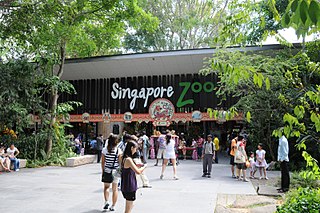
The Singapore Zoo, formerly known as the Singapore Zoological Gardens or Mandai Zoo, is a 28 hectares zoo located on the margins of Upper Seletar Reservoir within Singapore's heavily forested central catchment area. It is operated by the Mandai Wildlife Group, which also manages the neighbouring Night Safari, River Wonders, Bird Paradise as well as the forthcoming Rainforest Wild Park.

Whipsnade Zoo, formerly known as ZSL Whipsnade Zoo and Whipsnade Wild Animal Park, is a zoo and safari park located at Whipsnade, near Dunstable in Bedfordshire, England. It is one of two zoos that are owned by the Zoological Society of London (ZSL), a charity devoted to the worldwide conservation of animals and their habitats.
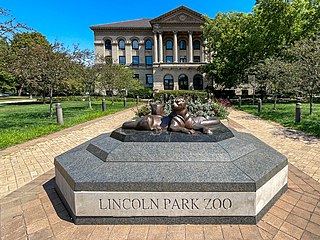
Lincoln Park Zoo, also known as Lincoln Park Zoological Gardens, is a 35-acre (14 ha) zoo in Lincoln Park, Chicago, Illinois. The zoo was founded in 1868 and is the second oldest zoo in the United States. It is also one of a small number of zoos to offer free admission. The zoo is an accredited member of the Association of Zoos and Aquariums (AZA). In 2019 it also became an accredited arboretum.

Chester Zoo is a zoo in Upton-by-Chester, Cheshire, England. Chester Zoo was opened in 1931 by George Mottershead and his family. The zoo is one of the UK's largest zoos at 51 hectares and the zoo has a total land holding of approximately 160 hectares.

The Berlin Zoological Garden is the oldest surviving and best-known zoo in Germany. Opened in 1844, it covers 35 hectares and is located in Berlin's Tiergarten. With about 1,380 different species and over 20,200 animals, the zoo presents one of the most comprehensive collections of species in the world.
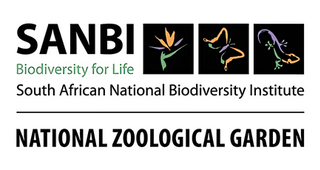
The National Zoological Garden of South Africa is an 80-hectare (200-acre) zoo located in Pretoria, South Africa. It is the national zoo of South Africa, and was founded by J. W. B. Gunning in 1899. Pretoria Zoo is one of the eight largest zoos in the world
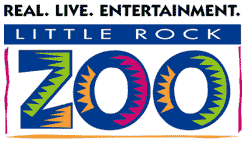
The Little Rock Zoo was founded in 1924 and is located in Little Rock, Arkansas, United States. It is home to more than 400 animals representing over 200 species, and covers an area of 33 acres (13 ha). The Arkansas Zoological Foundation is a private 501 c (3) organization that raises funds for zoo development. The Little Rock Zoo is a department of the city of Little Rock. It is the largest zoo in Arkansas, and the only Arkansas zoo accredited by the Association of Zoos and Aquariums (AZA).

Colchester Zoo is a zoological garden situated near Colchester, England. The zoo opened in 1963 and celebrated its 60th anniversary on 2 June 2023. The zoo is home to many rare and endangered species, including big cats, primates and birds as well as many invertebrates and fish species.

Wilhelma is a zoological-botanical garden in Stuttgart, southern Germany, located in the Bad Cannstatt district in the north of the city on the grounds of a historic castle. Wilhelma Zoo is one of the most popular tourist destinations in Baden-Württemberg, seeing more than 2 million visitors annually.

The Aktiengesellschaft Cologne Zoological Garden is the zoo of Cologne, Germany. Being the third oldest zoo in Germany, it features over 10,000 animals of more than 850 species on more than 20 hectares. The internationally renowned zoo with an attached aquarium and invertebrate exhibit is active in preservational breeding of animals that are in danger of becoming extinct. In addition, in-the-wild conservation efforts and research focussing on animals of Madagascar, Wallacea, and Vietnam are actively promoted and supported via cooperation with Cologne University and local projects, such as in the case of Przewalski's horses.
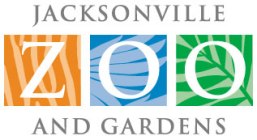
The Jacksonville Zoo and Gardens is located at the mouth of the Trout River, near where it flows into the St. Johns River, in Jacksonville, Florida. The zoo occupies approximately 122 acres (49 ha) and has over 2,000 animals and 1,000 plant species in its collection. The zoo has grown from a small collection in Springfield into one of the city's premier attractions, with more than one million visits annually.

Metro Richmond Zoo is a privately owned, for-profit zoo in Chesterfield County, Virginia. It is located in the central Virginia area, off of U.S. Route 360, about 20 miles southwest of Richmond. Metro Richmond Zoo encompasses about 70 acres (28 ha) and houses around 2,000 animals representing over 190 species, including reticulated giraffe, white rhinoceros, snow leopard, cheetah and Grant's zebra.
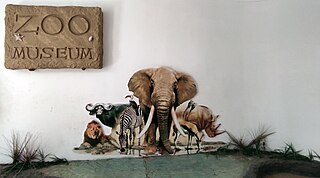
National Zoological Gardens of Sri Lanka is a zoological garden in Dehiwala, Sri Lanka, founded in 1936. It is home to various birds, mammals, reptiles, fish and amphibians. The zoo not only exhibits animals from Sri Lanka, but also exhibits species from across Asian and other parts of the globe.

Zoo Basel is a non-profit zoo in the city of Basel, Switzerland. Its official name is Zoologischer Garten Basel — or in English: Basel Zoological Garden. Basel residents affectionately call it Zolli. Its main entrance is just outside Basel's downtown strip of Steinen-Vorstadt and extends in the Birsig stream valley to Basel's city border with Binningen, Basel-Country. The zoo has over 500 animal species from all seven continents.

The Karlsruhe Zoo is a city garden with a zoo in the southwest of Karlsruhe, Germany. It also encompasses the outer area; Tierpark Oberwald in the southeast of the city. The main area totals 22 hectares, and the Oberwald Zoo has an area of 16 hectares. A total of around 3000 animals of over 240 species live at the Zoologische Stadtgarten Karlsruhe. The city garden is located north of the Karlsruhe Hauptbahnhof and south of the Karlsruhe Congress between the Karlsruhe districts of Südstadt and Südweststadt. The zoo was opened in 1865, making it one of the oldest zoos in Germany. The city garden and zoo form a common, enclosed area and cannot be visited separately.

Wingham Wildlife Park is a medium-sized wildlife park situated near Wingham, Kent, United Kingdom where it covers an area of 26 acres. In 2011, the species count at the park reached 180 species, growing to over 200 in 2013 covering fish, mammals, reptiles, amphibians, invertebrates and birds.
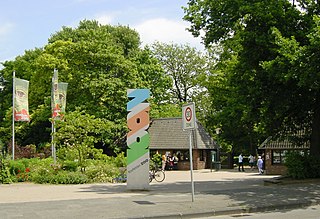
Krefeld Zoo is a zoo in the city of Krefeld, Germany, specialized in management of primates, carnivores, fauna from the African savanna and tropical birds.